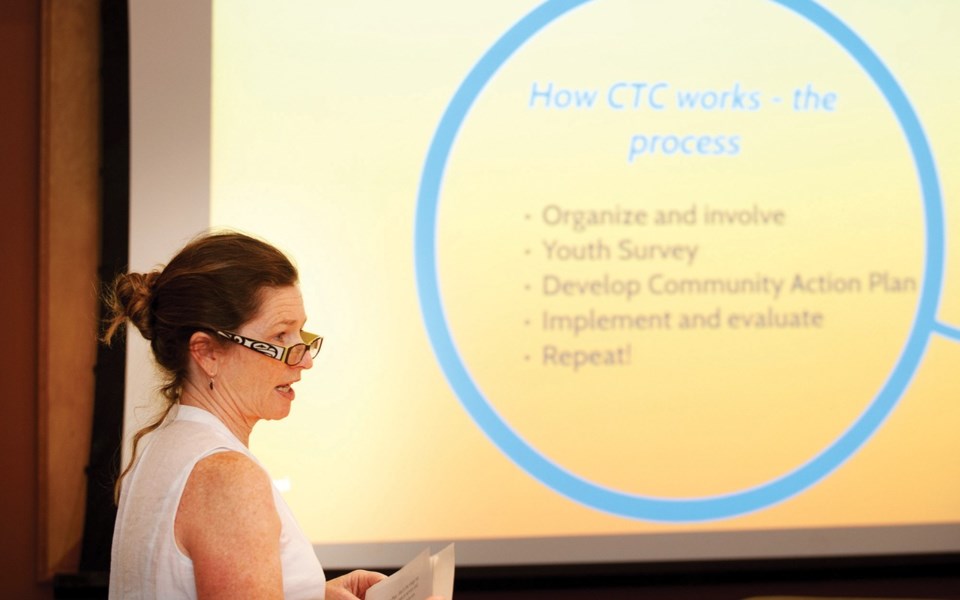Whistler's youth drink more often than their peers (and vape excessively), according to a new survey from Communities That Care (CTC)—but they also benefit from more opportunities.
CTC's 2017 Prevention Needs Assessment Survey was conducted in the fall of 2017, querying 461 students in Grades 6 to 12 about their alcohol, tobacco and drug use, as well as other antisocial behaviours.
It's the organization's fourth youth survey since 2003.
"I think that the thing that we have to recognize right off the bat is the strength in our community," said CTC chair Cathy Jewett, pointing to the high number of respondents who reported having three or more "protective factors" in their lives (such as being supported at home and school, having a belief in right and wrong, and having good social skills, to name just a few).
"The percentage that are considered 'high protection'—so they've got three or four protective factors in their lives—is much higher than the North American norm, so we're really encouraged by that," Jewett said.
Binge-drinking rates actually decreased for most grades (Grades 9 and 12 being the exceptions) since the last survey was conducted in 2013, but when compared with CTC's "Monitoring the Future" baseline (50,000 Grade 8, 10 and 12 students surveyed throughout North America), Whistler's youth binge-drink at nearly double the average rate.
While overall cigarette use was down 1.8 points to 15.8 per cent (2.4 points below the norm), vaping and the use of e-cigarettes is on the rise.
E-cigarette use increases with each grade level, with more than 50 per cent of the 2017-18 Grade 12 students reporting having used one in the past 30 days.
"That is, to me, something that is a big red flag," Jewett said.
"I don't think that there's a proper appreciation of the health risks that go along with that."
The survey also concluded that being drunk or high at school should remain a priority for prevention efforts (particularly for Grade 12 students), and that depressive symptoms in Grade 10 students (now in Grade 11) are an area of concern.
While the survey shows an overall declining rate of binge drinking, it's interesting to see the binge drinking increasing for Grades 9 (now Grade 10) and 12 (graduated), said Jackie Dickinson, executive director of the Whistler Community Services Society (WCSS).
"I think that's something to take note of: What is it about people that are transitioning into that next stage of school, or transitioning out of it, that is encouraging factors of not only drinking alcohol, but drinking excessively?" Dickinson said.
"And what, as a community, can we be doing to support people in that, and making sure that families are having critical dialogues with their kids around the risk factors?"
There's also a need to address the low perceived risk of drug use, shifting the conversation away from "drugs are bad and scary," Dickinson said.
"I think it's more important to shed light on why people use drugs," she said.
"When we can talk about the primary reasons or factors as to why people make good decisions and not-so-good decisions, that's way more meaningful when it comes to prevention-based education around drugs and alcohol."
The CTC survey, with its focus on relationships as protective factors, provides a good framework for parents wanting to set their kids on the right path.
"When kids feel like they belong, when they're being reinforced with positive behaviour, when they're connected with their family and doing positive things and making good decisions, that's ultimately what's going to support our kids in not engaging in high-risk behaviour and drug use," Dickinson said.
"If kids don't feel that sense of belonging within their families, they ultimately are looking for that somewhere else."
The Sea to Sky School District uses information from many different sources, including the CTC survey, to plan at both the school and district level, said director of instruction Phillip Clarke, in an email.
"As much as possible, we collaborate with our students, families and community partners through this planning," Clarke wrote.
"For example, we will continue to collaborate with Vancouver Coastal Health, (WCSS), our Parent Advisory Councils, and other community partners to talk with students about topics like healthy choices and mental health."
With the survey results, the hope is that parents will be empowered to have the important conversations with their kids.
"Our focus to a large extent has been to try to work with parents, to give them the tools to be able to deal with these issues and to recognize them," Jewett said.
Find the full survey on CTC's new website: www.ctcwhistler.ca.




